

 The Accurate Reloading Forums
The Accurate Reloading Forums  THE ACCURATE RELOADING.COM FORUMS
THE ACCURATE RELOADING.COM FORUMS  Guns, Politics, Gunsmithing & Reloading
Guns, Politics, Gunsmithing & Reloading  Reloading
Reloading  Neck tension question
Neck tension questionGo  | New  | Find  | Notify  | Tools  | Reply  |  |
| One of Us |
I am using the Lee collet neck sizing die for my 7-08 it seems and I may be wrong. But it seems that an inconsistant pressure could build up because I get a .4 variation in inside neck dia. What a I missing here or does the inside neck dia not matter? "I will not raise taxes on those making more than 250k" | ||
|
| One of Us |
Michael, in reloading you're looking for UNIFORM bullet release for accuracy. Some people swear by the Lee collet dies. I'm not a fan of the Lee collet dies. BUT..... that said..... where and at what stage are you taking neck measurements? Before or after the bullet is seated? | |||
|
| One of Us |
I am taking inside dia of the neck before I seat the bullet. I can see where outside neck dia can make a difference in pressure uniformity. If I am seating a .284 dia bullet in a .282 opening and same dia bullet in a .280 dia opening will the inside dia difference affect uniformity? I am thinking the .284 bullet will mold the brass equally regardless of inside dia. "I will not raise taxes on those making more than 250k" | |||
|
One of Us |
Still the question would be: how are you determining the ID of the neck? If you are using calipers then it will not be accurate. I use pin gauges that are accurate to within .001" 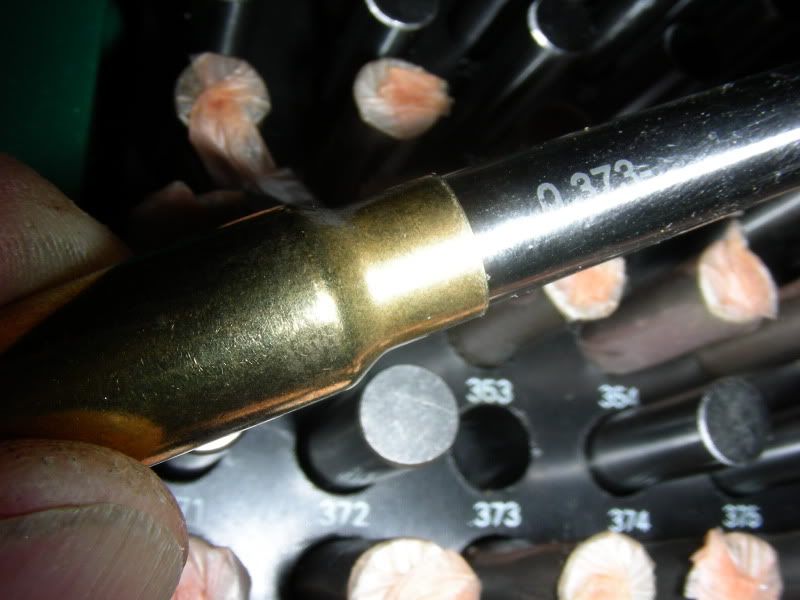 The Lee Collet has an interior mandrel and the neck is squeezed down onto that mandrel. I do not know how you could have that much variance since you will not be able to compress the solid metal mandrel and the collets make an easy job of sizing the brass down onto the mandrel. ____________________________________ There are those who would misteach us that to stick in a rut is consistency - and a virtue, and that to climb out of the rut is inconsistency - and a vice. - Mark Twain | Chinese Proverb: When someone shares something of value with you and you benefit from it, you have a moral obligation to share it with others. ___________________________________ | |||
|
| One of Us |
aha! I figured it was the cheap calipers considering the design of the collet die. "I will not raise taxes on those making more than 250k" | |||
|
| one of us |
.4" sounds a bit excessive, but one would assume you might have got your decimals mixed up?? Perhaps .004"?? Anyway, the Lee Collet die is a great die, loading straight ammo at ridiculously low (die) cost. But inconsistent neck tension is its weakness. In fact, it is probably a problem of all dies which set neck tension very low. In particular, as case necks work-harden with repeated reloadings, you'll find the problem to be more acute. What to do?? A few options: Use only newish cases. Anneal case necks. Polish down mandrel .001-.002" to give you more neck tension. Buy under-size mandrel from Lee... Sometimes it is also possible to get more neck tension by turning the die further into your press. But watch it, this only works so far, beyond which point you may observe unwanted effects such as increasing the shoulder diameter of the fired case (does not work wonders for chambering!). Repeated sizing of the same case (turning case every time), and application of "correct" pressure to the press handle may also sometimes help (a bit). Again, also this can be overdone., I have managed to blow off the top of two Collet dies by attempting to apply too much pressure. Don't ask me how that happened, or whether perhaps the die was faulty? But it is a sinking feeling when the aluminium top cap gets blown off the die... - mike ********************* The rifle is a noble weapon... It entices its bearer into primeval forests, into mountains and deserts untenanted by man. - Horace Kephart | |||
|
| one of us |
Hell, his first sentence had me scratching my head
| |||
|
| One of Us |
yes oops not used to decimals it is a 0.004 variance but as mentioned the calipers are not the best to measure ID with the pin guages are. Where can I get some pin guages? "I will not raise taxes on those making more than 250k" | |||
|
| one of us |
First, I like the Lee Collet die design and use this die on every caliber to which it is appropriate. There are some caveats on its care and feeding, however. First, all brass will have some degree of springback. The softer the neck, the less springback it will exhibit. Therefore, if you are sizing brass of different brands, or lots, or fired a different number of times, then the necks will unavoidably be of slightly differing hardnesses and therefore will have varying springback, and therefore will have slightly differing inside diamters after being sized on a Lee Collet die. This is NOT a shortcoming of the die design, in that those same cases would have the same varying springback if sized on a conventional die which EXPANDS the case neck as the final sizing step whereas the Lee CONTRACTS the case neck as the final step. The springback is the same either way, it's just that the harder the case neck the smaller its finished diameter with a conventional die, and the larger its diameter with a Lee die. Owning and using Lee Collets for around a dozen calibers, I find that the sizing mandrel/decapper almost always merits honing down by around .002" or so in order to generally achieve the neck tension I desire. Lee argues otherwise, but I find that a very slightly undersized neck, whether it is a "hard" neck or a "soft" one, tends to give more consistent bullet pull. I also chamfer all of my necks with a Lyman VLD tool (very long taper) so that the entry of the bullet into the case neck is smooth and no jacket material is shaved in the seating process. To reduce your mandrel size, simply chuck it in a drill (drill press is better) and wrap a piece of emory cloth around it like a shoe-shine cloth. It takes surprisingly little honing to remove .002" or .003" of diameter, so hone cautiously. I like to reduce the diameter of the mandrel at the point where the neck presses against it during resizing, but leave it a little fatter near the bottom tip. This way the case neck is reduced, but it also is uniformed a bit as it slides over the slightly larger tip on the way out. Another tip that I feel gets you more uniform necks is to "size twice". This is really easier than it sounds and not very time consuming. As you withdraw the case partway on the downstroke of the press ram afer sizing, take the fingers of your free hand and rotate the case only 22.5 degrees (this ain't possible to do precisely, just keep the rotation well below 45 degrees). Then run the case back into the die once again. This will result in the petals of the collet hitting the case approximately half-way in between where they did the first time, resulting in a very slightly tighter neck and, theoretically, a very slightly rounder neck. And more case-to-case uniformity. Don't attempt to get tighter necks by turning the die too far into the press. Excessive force only deforms the bottom edge of the collet where it bears against the shellholder, resulting in shortened die life. Lee says not to allow your press to "cam over". B.S. Not all presses will cam-over, but if yours will and you set the die so that the desired pressure comes exactly at the cam-over point, then by camming-over you will get EXACTLY the same pressure applied to every case. Lee assumes that since the leverage at the cam-over point becomes infinite that reloaders can't avoid placing too much pressure on the die if they allow the press to cam-over. That's faulty thinking as the pressure at the cam-over point depends on how far into the press the die is screwed (although Lee realizes that many reloaders would put way too much pressure on the die if they do set their press to cam-over.) More info than you asked for, but what the heck, it didn't cost you anything | |||
|
| One of Us |
thanks stonecreek so what is the inside dia of the neck you aim for? 0.002 less than bullet dia? "I will not raise taxes on those making more than 250k" | |||
|
One of Us |
I got mine from CDCO (can't link directly to the page but click on Measuring Tools, Gage Blocks & Pin Gauges and then it is the 3rd one on the right .251 - .500 for $65.00). It is up $10.00 from when I bought mine 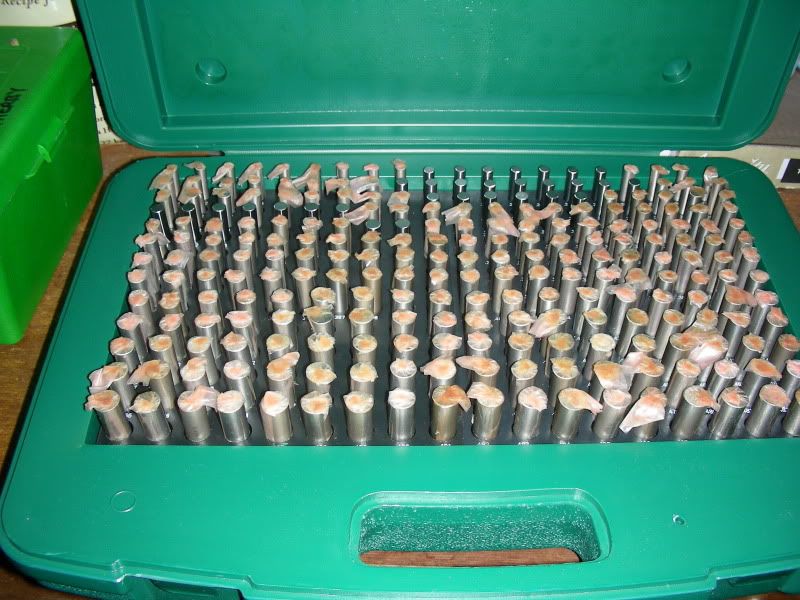 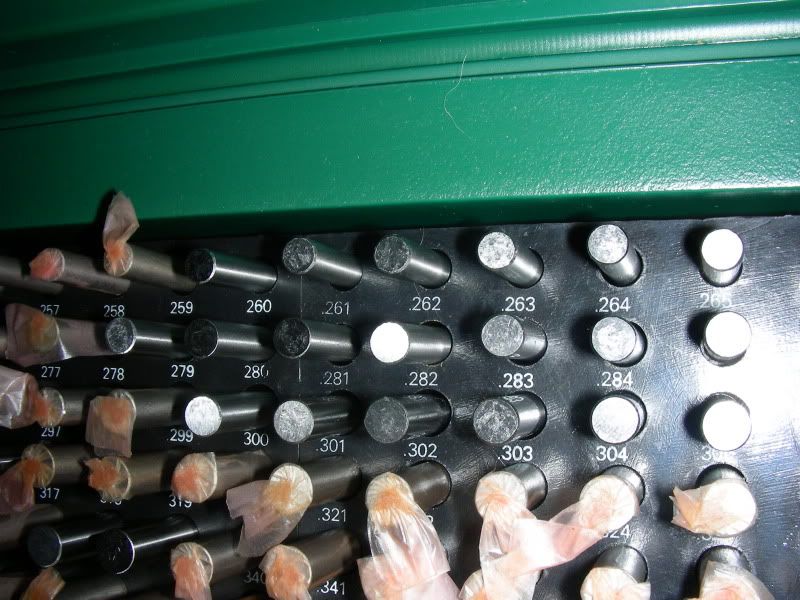 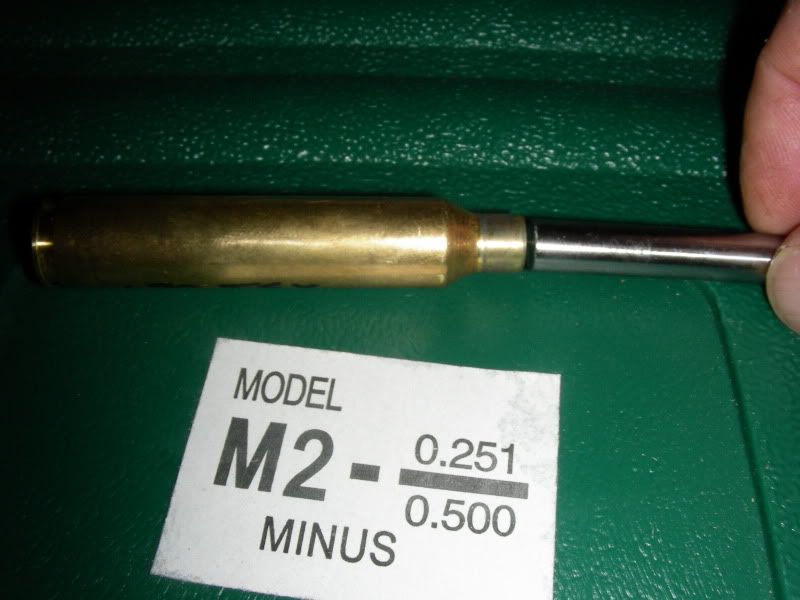 Unlike Stonecreek I did not have good luck with honing down the diameter of a Lee Collet mandrel but did order some in different sizes from Lee, cost was $5.00 apiece after you hit the minimum order dollar figure 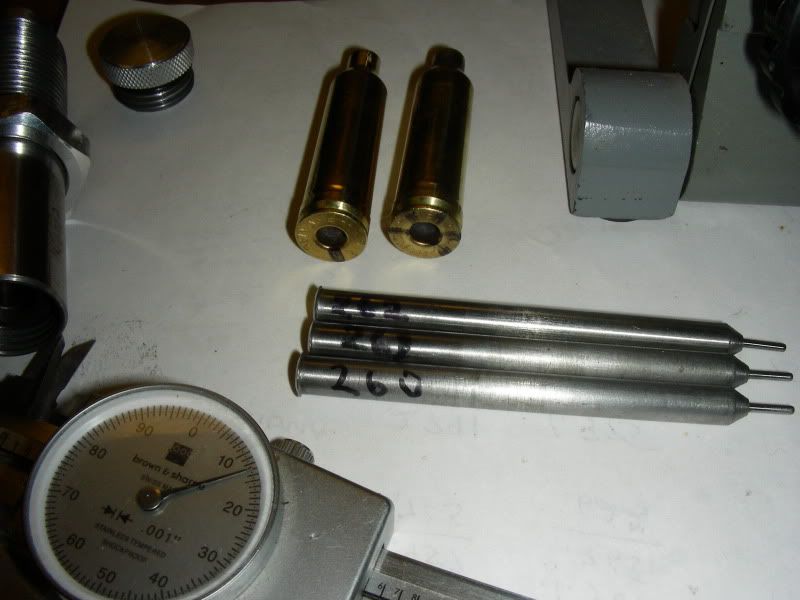 BTW my preference is to size the ID of the neck to .003" less than bullet diameter. In tests I have done .002" seems to be a threshold where a greater bullet grip will not do any additional good. IOW if I size a case neck ID much smaller and pull the bullet it will return to .002" less than bullet diameter, likewise if I size it to .003" less it will still return to .002" less than diameter. The effort of stretching the brass when seating the bullet is greater and that is what puts more pressure on your seating process and will eventually lead to additional runout. ____________________________________ There are those who would misteach us that to stick in a rut is consistency - and a virtue, and that to climb out of the rut is inconsistency - and a vice. - Mark Twain | Chinese Proverb: When someone shares something of value with you and you benefit from it, you have a moral obligation to share it with others. ___________________________________ | |||
|
| one of us |
That is a nifty tool, Woods. Got to have one of those - much to the chagrin of Hot Core, I presume Like Woods, I also tend towards a bit more neck tension. IMHO, sizing for very low neck tension is fine if you are prepared to do perfect brass preparation: outside turning for consistent neck wall thickness, annealing to minimize issues of work hardening etc. If you are not willing to go that way, low nominal neck tension will show up as varying neck tension (you can feel it when you seat bullets), and that is not good for accuracy. Using a bit more tension seems to minimize the effects of varying brass (and brass always seems to vary...). - mike ********************* The rifle is a noble weapon... It entices its bearer into primeval forests, into mountains and deserts untenanted by man. - Horace Kephart | |||
|
| one of us |
The difference is easy to discern - the only time a Thingy is useful, is when the (PT Barnum) Salesman pockets the $$$Money$$$ for having SOLD IT!!! | |||
|
| One of Us |
There is still so, so much I have to learn! | |||
|
| One of Us |
thanks this info is very helpful, really puts the neck ID dimension and tension into perspective. "I will not raise taxes on those making more than 250k" | |||
|
| One of Us |
Neck tension could be influenced by springback of the brass. By annealing the case necks it would help only one reason for variation in neck tension. I agree with rest of forum you must measure and problably also cut necks to a uniform thickness. The latter is a topic on it's own. | |||
|
| Powered by Social Strata |
| Please Wait. Your request is being processed... |
|

Visit our on-line store for AR Memorabilia

